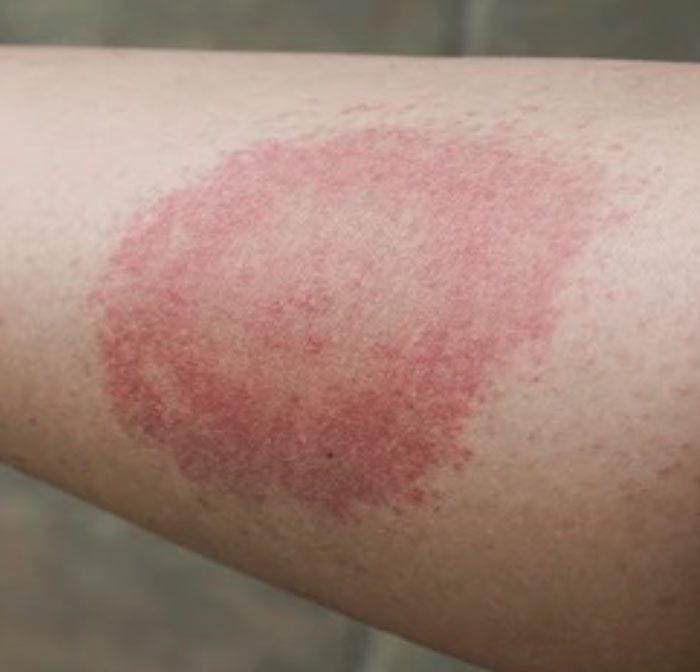Blog

Written by Julie Bick, Ph.D.
Introduction
I am pretty sure that many of us have experienced this scenario- You've just returned from a serene hike through the woods, only to find an unwelcome hitchhiker on your skin—a tick. For many of us there is a sense of panic and perhaps even fear at the potential challenges of removing it, coupled with the unknown diseases that it might be carrying. So, what should you do if you find yourself in this situation? Within this blog, we’ll walk you through the steps to take if you've been bitten by a tick, as well as provide some simple but effective tips on how to avoid tick bites altogether.
Understanding Ticks
Before exploring what to do when bitten, it's essential to understand this increasingly prevalent adversary. Ticks are tiny arachnids belonging to the order Parasitiformes, and they thrive in wooded areas, tall grasses, and shrubs. They are found in all continents- including Antarctica (for you hard-core entomologists Antarctica’s Ixodes uriae, also known as the Seabird Tick) – with more than 800 species described globally. While many ticks are harmless, some species can transmit pathogens that cause diseases such as Lyme disease, Rocky Mountain spotted fever, and babesiosis, to name a few. Unfortunately, this is a growing problem due to many factors including climate change (Gilbert, 2021).
Ticks typically attach themselves to the skin of animals or humans to feed on blood. They use specialized mouthparts to anchor themselves firmly in place while they can feed over several days. Right after attaching to the skin, the ticks spit lines of saliva containing a glue-like substance to secure its attachment, followed by saliva containing a plethora of compounds that work to dilate blood vessels, numb the pain and itching associated with a typical insect bite through anti-inflammatory and analgesic compounds, as well as molecules that work to evade the host immune system (Anderson and Brissette, 2021). As elegant from a scientific perspective as this is, it is also the mechanism through which bacteria, viruses and parasites are transmitted so readily from tick to host.
Identifying a Tick Bite
Because of the analgesic compounds in tick saliva, tick bites are often painless, which can make them easy to miss. However, there are some signs to watch out for. The most obvious sign is the presence of the tick itself. Ticks vary in size and color depending on the species and their stage of development. They may appear as tiny black dots or larger, engorged insects, so it is always advised to take a shower and wash thoroughly after a hike, or while working outside. Not only will this help you examine most parts of your body, but it may also wash away ticks that haven’t latched on!
However, if you have been bitten by a tick you may notice redness and swelling around the affected area. This is the body's natural response to the tick's saliva, which does contain substances that can cause irritation. In the case of Lyme disease, a characteristic bullseye rash (also known as erythema migrans) may develop around the site of the tick bite (Steere et. Al. 1978). This rash typically appears within 3 to 30 days after the bite and expands outward in a circular pattern.

Fig. 1. Typical erythema migrans rash associated with Lyme disease.
What to Do if You've Been Bitten
If you find a tick attached to your skin, don't panic- not all ticks carry parasites, and it takes a significant period of time (hours to days) for any infective agents to be transferred from the tick into your body. But the quicker you take action, the lower the risk of contracting an infection- so act fast!
So first and foremost, you’ve got to remove the tick. This is best achieved using fine-tipped tweezers to grasp the tick as close to the skin's surface as possible. Pull upward with steady, even pressure, being careful not to twist or jerk the tick, as this can cause the mouthparts to break off and remain embedded in the skin. If you don't have tweezers, you can use a tick removal tool or seek assistance from a healthcare professional at an Urgent Care Center for example. How ever you remove the tick, resist the urge to flush it down the toilet and keep the tick in a sealed container. Knowing the species of tick can help healthcare providers assess the risk of disease transmission, and many labs now offer services to screen ticks for pathogens, which could be useful if you subsequently develop symptoms of an infection.
Here is a link to an easy step by step video on how to remove a tick:
How to properly remove a tick (youtube.com)
After successfully removing the tick, thoroughly clean the bite area with soap and water or an antiseptic solution. This will help prevent infection.
Over the next few days,keep an eye on the bite site for any signs of infection or illness. If you develop a rash, flu-like symptoms, fever, aches or other symptoms, seek medical attention promptly and inform your healthcare provider that you were bitten by a tick.
With tick-borne diseases becoming more commonplace, here are the ones you need to know about.
Lyme Disease: Caused by the bacterium Borrelia burgdorferi, Lyme disease is transmitted by black-legged ticks (also known as deer ticks- see figure 2). Early symptoms of Lyme Disease can include fever, headache, fatigue, and a characteristic bullseye rash. If left untreated, there is a risk of developing a serious condition known as chronic or long-term Lyme disease that can lead to joint pain, heart palpitations, and various neurological problems; so it is important to get a Lyme test if you feel you’ve had an exposure or display symptoms. It is also important to get the right Lyme test -at Incite Health we offer the MTTT test that is very sensitive at detecting early Lyme infection. If your test result comes back negative at first, but you are still experiencing symptoms, then get re-tested. It can take some time for your immune response to infection to develop, and this response is required for accurate Lyme testing.

Fig. 2. Black-legged tick. The females have the light brown color, but the males are all dark.
Rocky Mountain Spotted Fever (RMSF): RMSF is caused by the bacterium Rickettsia rickettsii and is transmitted by the American dog tick, the Rocky Mountain wood tick, and the brown dog tick. Symptoms may include fever, headache, rash, and nausea. Without prompt treatment, RMSF can cause serious complications, including organ failure and death. Clinical tests for RMSF either screen for Rickettsia DNA in blood using PCR, use immunohistochemistry to screen for Rickettsia antigens in tissue, or serology testing to identify antibodies produced to target Rickettsia. As with Lyme Disease screening, it is important to get the right diagnostic test at the right time, so if you are experiencing symptoms after a negative test result, talk with your physician about re-testing, or a different form of diagnostic screen.
Babesiosis: Babesiosis is caused by microscopic parasites of the genus Babesia, which are transmitted by black-legged ticks. Symptoms may include fever, chills, sweats, fatigue, and muscle aches. In severe cases, babesiosis can cause hemolytic anemia and even organ failure. Clinical screening for Babesiosis either involves PCR screening of blood for Babesia DNA, or the direct observation of Babesia parasites in red blood cells. There are also serology tests for chronic or late-state Babesiosis infection.
Anaplasmosis and Ehrlichiosis: These bacterial infections are transmitted by black-legged ticks and lone star ticks, respectively. Symptoms may include fever, headache, muscle aches, and fatigue. In severe cases, anaplasmosis and ehrlichiosis can cause respiratory failure and organ damage. Both infections are typically screened using PCR to identify parasite infection in blood. There are serology assays for both Anaplasmosis and Ehrlichiosis, but these have limited use since it can take weeks or even months for antibodies to be produced, resulting in false negatives for early infection.
Given the complexity and variability in symptoms of many tick-borne diseases, many infectious disease specialists use a more comprehensive approach to the diagnosis of Lyme-coinfections; this includes a thorough clinical evaluation coupled with the patient’s previous clinical history, a combination of serology and molecular testing that is often repeated overtime, coupled with evaluation of symptoms, exposure history and clinical judgement.
Treatment for Lyme disease and coinfections typically involves the use of prolonged antibiotic therapies that target the underlying pathogens; typically Doxycycline is a component of any treatment plan. The specific antibiotic(s) and duration of treatment may vary depending on the type of coinfection and the severity of symptoms. In some cases, individuals with severe or persistent symptoms may require hospitalization and intravenous antibiotics.
Preventing Tick Bites
Prevention is key when it comes to avoiding tick-borne diseases. Here are easy but critical tips to reduce your risk of tick bites.
If you are heading outside for any extended period of time, always apply insect repellent. The most effective insect repellents contain DEET, but if you want to avoid DEET then applying products containing picaridin, or oil of lemon eucalyptus to exposed skin and clothing before heading outdoors can provide effective protection.
Wear Protective Clothing. This means wearing long sleeves, pants, and socks to minimize exposed skin, and then tucking your pants into your socks for added protection. With new moisture wicking technologies in clothing, this means you can remain comfortable even in the middle of summer.
Perform Tick Checks. After spending time outdoors, thoroughly check your body for ticks, paying close attention to areas such as the scalp, behind the ears, and in the groin area.
Avoid Tick Habitats. Stay on trails when hiking and avoid wooded or grassy areas, especially during peak tick season (spring and summer).
Don’t’ forget your best friends. Use tick prevention products on pets and check them regularly for ticks, as pets can carry ticks indoors.
Create a Tick-Free Zone. As much as possible keep your yard tidy by mowing the lawn regularly, removing leaf litter, and trimming bushes and shrubs. Some professional pest control professionals offer targeted tick-prevention services.
Key Take Home Points
Lyme disease and its’ potential coinfections are a serious health concern that can complicate the diagnosis and treatment of tick-borne illnesses. By understanding the symptoms of coinfections, seeking prompt testing and medical attention, along with taking steps to prevent tick bites, you can significantly reduce your risk of Lyme disease and coinfections and protect your health and well-being. If you suspect that you may have been exposed to ticks or are experiencing symptoms of Lyme disease or coinfections, don't hesitate to contact your healthcare provider for diagnostic screening, evaluation and treatment. With proper care and attention, you can stay healthy and enjoy the outdoors safely.
References
- Gilbert, L 2021 The Impacts of Climate Change on Ticks and Tick-Borne Disease Risk. Annual Review of Entomology vol. 66: 373-388. https://doi.org/10.1146/annurev-ento-052720-094533
- Anderson, C.; Brissette, C.A. The Brilliance of Borrelia: Mechanisms of Host Immune Evasion by Lyme Disease-Causing Spirochetes. Pathogens 2021, 10, 281. https://doi.org/10.3390/pathogens10030281
- Steere, A.; Broderick, T.F.; Malawista, S.E. Erythema chronicum migrans and Lyme arthritis: Epidemiologic evidence for a tick vector. Am. J. Epidemiol. 1978, 108, 312–321

